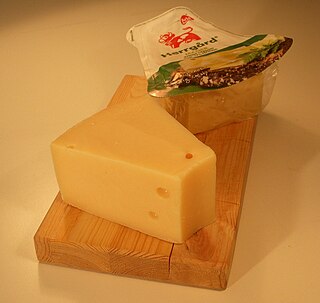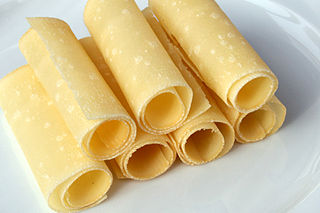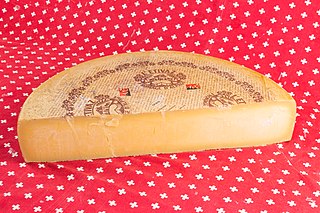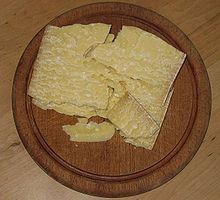
The term "Swiss cheese" is one used of any variety of cheese that resembles Emmental cheese, a yellow, medium-hard cheese that originated in the area around Emmental, Switzerland. It is classified as a Swiss-type or Alpine cheese. The term is generic; it does not imply that the cheese is actually made in Switzerland. Some types of Swiss cheese have a distinctive appearance, as the blocks or rounds of the cheese are riddled with holes known as "eyes". Cheese without eyes is known as "blind".

Gruyère is a hard Swiss cheese that originated in the cantons of Fribourg, Vaud, Neuchâtel, Jura, and Berne in Switzerland. It is named after the town of Gruyères in Fribourg. In 2001, Gruyère gained the appellation d'origine contrôlée (AOC), which became the appellation d'origine protégée (AOP) as of 2013.

Fondue is a Swiss melted cheese and wine dish served in a communal pot over a portable stove heated with a candle or spirit lamp, and eaten by dipping bread and sometimes vegetables into the cheese using long-stemmed forks. It was promoted as a Swiss national dish by the Swiss Cheese Union in the 1930s, and was popularized in North America in the 1960s.

Cheesemaking is the craft of making cheese. The production of cheese, like many other food preservation processes, allows the nutritional and economic value of a food material, in this case milk, to be preserved in concentrated form. Cheesemaking allows the production of the cheese with diverse flavors and consistencies.

Swiss cuisine is an ensemble of national, regional and local dishes, consisting of the ingredients, recipes and cooking techniques developed in Switzerland or assimilated from other cultures, particularly neighboring countries. The diversity and comprehensiveness of Swiss gastronomy reflects the linguistic, cultural and geographical diversity. The climate of Switzerland allows for a large variety of terroirs, and therefore a wide range of indigenous food, from simple cereals to refined products like cheese and wine.

Emmental, Emmentaler, or Emmenthal is a yellow, medium-hard cheese that originated in the Emme valley, Switzerland. It is classified as a Swiss-type cheese.

Beaufort is a firm, raw cow's milk cheese associated with the gruyère family. An Alpine cheese, it is produced in Beaufortain, Tarentaise valley and Maurienne, which are located in the Savoie region of the French Alps.

Herrgårdsost is a semi-hard Swedish cheese made from cow's milk. The aged cheese has a mild, nutty and creamy taste. The cheese has small round holes and a waxed surface. Herrgårdsost is usually manufactured in wheels about 40 cm (16 in) in diameter and 12 cm (4.7 in) wide, weighing around 14 kg (31 lb).

Bergkäse refers to a number of varieties of cheese produced in the Alps. This includes products of mountain farming, the cultivation of alpine pastures as well as the milk processing of local producers in dairies. The term does not say much about the type or production method of the product called mountain cheese, which is usually a hard or semi-hard cheese with no or little holes, usually with a natural rind, but there are also semi-hard cheeses and soft cheeses under this designation. The term is used also generically for Swiss-type or Alpine cheeses, which resemble these in taste and texture but do not come from one of the traditional cheese making regions. The texture is rather hard, sometimes with small holes or cracks, the flavour strong and often a bit nutty.

Vacherin Fribourgeois a Swiss semi-hard cheese made from thermised milk. It is produced under Swiss AOC in the canton of Fribourg, where Gruyère also originates. It has a slightly acidic, resiny flavor, akin to Italian Fontina, with a varying strength depending on the age and type. It is also a basic component lending character to fondues. Vacherin Fribourgeois has Swiss AOC status with 6 varieties being available:

Granular cheese, also known as stirred curd cheese and hard cheese, is a type of cheese produced by repeatedly stirring and draining a mixture of curd and whey. It can refer to a wide variety of cheeses, including the grana cheeses such as Parmigiano-Reggiano (pictured) and various others.

L'Étivaz is a hard Swiss cheese made from raw cow's milk. It is classified as a Swiss-type or Alpine cheese, and is very similar to Gruyère surchoix in taste.

There are many different types of cheese. Cheeses can be grouped or classified according to criteria such as length of fermentation, texture, methods of production, fat content, animal milk, and country or region of origin. The method most commonly and traditionally used is based on moisture content, which is then further narrowed down by fat content and curing or ripening methods. The criteria may either be used singly or in combination, with no single method being universally used.

Cheese ripening, alternatively cheese maturation or affinage, is a process in cheesemaking. It is responsible for the distinct flavour of cheese, and through the modification of "ripening agents", determines the features that define many different varieties of cheeses, such as taste, texture, and body. The process is "characterized by a series of complex physical, chemical and microbiological changes" that incorporates the agents of "bacteria and enzymes of the milk, lactic culture, rennet, lipases, added moulds or yeasts, and environmental contaminants". The majority of cheese is ripened, except for fresh cheese.

Berner Alpkäse is a hard cheese produced in the Alps of the Bernese Oberland and adjacent areas of Switzerland. It is classified as a Swiss-type or Alpine cheese, and is a spicy, full-fat, raw milk cheese without holes. The cheese is manufactured exclusively with manual labour, usually on a wood fire. An extra-hard variety of Berner Alpkäse, known as Berner Hobelkäse, is aged for at least two years and it is this variety that is most widely available. Both Berner Alpkäse and Berner Hobelkäse are certified as AOPs in Switzerland.

Swiss-type cheeses, also known as Alpine cheeses, are a group of hard or semi-hard cheeses with a distinct character, whose origins lie in the Alps of Europe, although they are now eaten and imitated in most cheesemaking parts of the world. Their distinct character arose from the requirements of cheese made in the summer on high Alpine grasslands, and then transported with the cows down to the valleys in the winter, in the historic culture of Alpine transhumance. Traditionally the cheeses were made in large rounds or "wheels" with a hard rind, and were robust enough for both keeping and transporting.

Alpkäse is a type of cheese made with cow's milk in the Alpine region. It is classified as a Swiss-type or Alpine cheese.

In Switzerland, the appellation d'origine protégée is a geographical indication protecting the origin and the quality of traditional food products other than wines.

Switzerland has a strong and ancestral dairy farming and cheesemaking tradition. The breeding of cattle, sheep and goats for milk is attested in the Neolithic period and, since Antiquity, cheese has been exported from the Alpine regions. The rugged nature of the country makes approximately 80% of the agricultural land unsuitable for cultivation, which is therefore mainly exploited for cattle and sheep farming. This mode of exploitation has forged a large part of the Swiss landscape, in the Alps, the Jura and on the Swiss Plateau.

Ziger (German), Sérac (French) or Ricotta (Italian), is a group of fresh cheeses originating in Switzerland. Ziger is nationally widespread as it is the by-product of the manufacture of hard Swiss-type cheeses, such as Gruyère and Emmental. Made of whey, it is rich in proteins and it is historically a staple food in the Alpine regions.
























